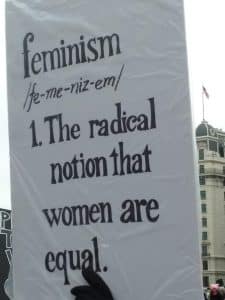 “Quick! Grab her!” The woman was pulled from the river, battered and bruised from the treacherous rapids. Nearly drowned, she gasped for breath. But before she could get more help the rescuers were back in the water, pulling another victim out. Woman after woman were floating by. “What can we do?!” someone shouted. “There are too many of them!” Finally, someone runs upstream to determine where all these bodies are coming from.
“Quick! Grab her!” The woman was pulled from the river, battered and bruised from the treacherous rapids. Nearly drowned, she gasped for breath. But before she could get more help the rescuers were back in the water, pulling another victim out. Woman after woman were floating by. “What can we do?!” someone shouted. “There are too many of them!” Finally, someone runs upstream to determine where all these bodies are coming from.
The past year has seen an increase in conversations on sexual and domestic violence. Many people have spoken up for the first time about the abuse they have lived through. It has others questioning “gray areas,” wondering what constitutes rape and what was simply a bad sexual encounter. It has highlighted intersectionality and brought attention to the margins, where instances of violence are more likely to occur. It has again brought to forefront the underlying ideas and values which contribute to statistics showing that every nine seconds a woman in the US is assaulted or beaten, and worldwide the fact that one in three women will be abused or coerced into sex in their lifetime.
Jane Doe Inc. (JDI), a sexual and domestic violence coalition, seeks to understand violence and work toward prevention through a gender analysis of violence. They purport that “the primary cause of sexual and domestic violence is the deeply embedded social norm that values power over another rather than equality and human rights.” JDI points to the history of women being viewed as property and having strict gender roles as crucial to understanding assault.
Violence against women is not a new phenomenon. Starting in the first book of the Bible, we have stories of the mistreatment of women. Exponent blogger, EM, illustrates assault with the story of Abram, Sarai and Hagar from Genesis 16 and 21. “Hagar is already a victim because she is enslaved. Then, as so many enslaved women have been across the centuries, she is sexually assaulted. It is useless to claim that perhaps she enjoyed it, or wanted it, or liked Abram. Firstly, the scriptures indicate no such thing, and more importantly, she did not have the freedom to say no. Consent is meaningless if a person cannot freely refuse sexual advances.”
Throughout the Bible, rape is seen as a crime against a family’s property. Individual rights and personhood are not considered. Commenting on the rape laws found in Deuteronomy 22, Cheryl Anderson says, “Clearly, these laws do not take into account the female’s perspective. After a rape, [the victim] would undoubtedly see herself as the injured party and would probably find marriage to her rapist to be distasteful, to say the least. Arguably, there are cultural and historical reasons why such a law made sense at the time. Just the same, the law communicates the message that faith tradition does not (and should not) consider the possibility that women might have different yet valid perspectives.”
The Bible is generally not a source that promotes gender equality. Instead, it upholds cultural norms that view women as second-class. This is not to say that the Bible holds no truth or value, but to point out that it, as with other historical documents, will be steeped in the values of its time. This should not be used as reason to perpetuate inequality in the present. Just because women were rarely included in the past, does not mean we should continue to silence women today.
Women, children, people of color, immigrants, and others throughout history have struggled to be heard. It is not just that the violence was perpetuated against these groups, but when they raise their voices, who will believe them? To whom do they report? They are revictimized by systems and structures that place the blame on them and offer no recourse.
Shakespeare pointed out this problem in his play, Measure for Measure. In this work on mercy and compassion, Angelo sentences Claudio to death for immorality. Angelo sees himself as virtuous, but when Claudio’s sister, Isabel, comes to plead for her brother’s life, Angelo finds himself lusting after her. He proposes that he will spare Claudio’s life if Isabel yields her virginity to him. She refuses and threatens to reveal his evil designs.
He says:
Who will believe thee, Isabel?
My unsoil’d name, the austereness of my life,
My vouch against you, and my place i’ the state,
Will so your accusation overweigh,And her reply:
To whom should I complain? Did I tell this,
Who would believe me?
What I find so interesting is how Shakespeare highlights Angelo’s use of authority as a way to try and force his way into Isabel’s life. I remember my first conversation on rape when I was about 13 or 14 years old. My bishop’s wife had survived an attempted rape outside her office one night. It was the “typical” story: a stranger jumping out of the bushes in the dark. Because of her experience we had a YW/RS activity on self-defense. What was not discussed was the fact that “typical” rapes are more often committed by someone the victim knows, trusts, or who is in a position of power and authority. Also absent from the conversation was that rape can happen in marriage.
It wasn’t until the mid-1970s that men were first prosecuted for marital rape in the US. By 1993 all 50 states had removed some of the marital exemptions from rape laws. However, a 2003 study showed 26 states still had some form of marital immunity, such as the Tennessee law stating marital rape occurred only if a weapon was used or serious bodily injury resulted. In 2015, Utah lawmakers were discussing whether rape occurred if the victim was unconscious. The Salt Lake Tribune quoted Holly Mullen of the Rape Recovery Center saying, “Instead of dicing and parsing and saying, ‘Well, what about a wife if she’s asleep?’ just look at what is happening and the prevalence of sexual assault in our world. It’s a tool of power. That might be why they’re parsing. They don’t want to look at what is really going on around them.”
Naming a problem and raising awareness of the issue is often the first step toward change. This is the power of consciousness-raising-groups, which feminists started in the late 1960s. Women came together to share their personal stories, discussing topics long considered taboo. The personal became political as women found support and courage to face their oppression and push for change.
As a result of feminist activism, domestic violence emerged from the shadows and resources for battered women started to appear. The first rape crisis center in the US opens in 1971 followed by the first battered women’s shelter in 1973. By 1978 there were over 300 shelters, hotlines, and groups advocating for abused women.
One of my favorite activists, Rebecca Solnit, writes beautifully on the ties between violence and silence.
Violence against women is often against our voices and our stories. It is a refusal of our voices, and of what a voice means: the right to self-determination, to participation, to consent or dissent; to live and participate, to interpret and narrate.
A husband hits his wife to silence her. A date rapist or acquaintance rapist refuses to let the “no” of his victim mean what it should, that she alone has jurisdiction over her body. Rape culture asserts that women’s testimony is worthless, untrustworthy… These are assertions that the victim has no rights, no value – is not an equal.
Having a voice is crucial. It’s not all there is to human rights, but it’s central to them, and so you can consider the history of women’s rights and lack of rights as a history of silence and breaking silence.
Last year, Time Magazine named “The Silence Breakers” the 2017 Person of the Year, referring to the millions of women who came forward about sexual assault and harassment in the #MeToo campaign. There was something powerful in the collective voice that rose against the abuse and shame that kept women fearful for so long.
Yet at the same time, I have felt more overwhelmed than ever thinking about the scope of violence against women and how far we still have to go. It has been especially disheartening to see the Church’s lack of response to the #MeToo movement and reaction to specific cases such as McKenna Denson or Sam Young’s petition to end one-on-one interviews.
As I reflect on the weight of this global problem and work through my own experiences of assault, I find hope. This comes to me through simple means, like having space to raise my voice, and kind friends who listen and help me process my anger. Little things matter. Speaking up matters. Maybe we don’t make a difference in the Church. Maybe things continue to change laboriously slow in society. But an important part of personal growth is the empowerment that comes from speaking up. Our voices, and creating space for others to speak, can make a difference for our families, our friends and ourselves.
This is the first in a three-part series. Part two will review the MeToo movement in the Mormon community and part three will offer suggestions for action.
Selected Bibliography
Anderson, Cheryl. Ancient Laws and Contemporary Controversies: The Need for Inclusive Biblical Interpretation. Oxford University Press, 2009.
Jane Doe Inc. The Massachusetts Coalition Against Sexual Assault and Domestic Violence
Lapidos, Juliet. In Utah, Wondering What Rape Really is.
Morris, Bonnie and DM Withers, The Feminist Revolution: The Struggle for Women’s Liberation. Smithsonian Books, 2018.
Solnit, Rebecca. Silence and powerlessness go hand in hand – women’s voices must be heard.






3 Responses
This is very interesting. In the Deseret News there is an article about Robert Kirby telling another report to “pretend I picked you up from an escort service. . . ” He issues an apology but says he was “joking” and that he “misjudged how she would take [his] sense of humor.”
A year ago my husband woke me up from a dead sleep pulled off my pajama bottoms and had sex with me. I was barely awake and struggling to process what was happening. When he finished he rolled over and went to sleep. I lay awake for hours afterward listening to him snore.
[…] is the second in a three-part series. Part one reviewed the history of violence against women and part three will offer suggestions for […]